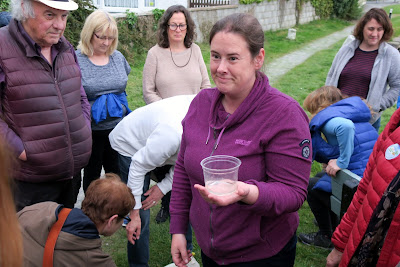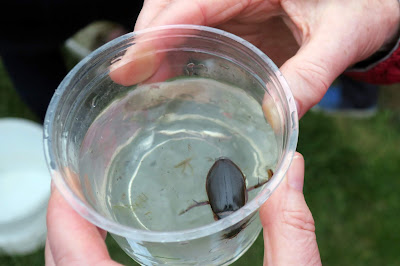Out of Town: a biodiversity walk in Ireland's 'Venice'
"Each one of us can make a decision in our own garden."
That was just one takeaway from a walk by the canal in Monasterevin last evening organised in conjunction with Biodiversity Week 2019, writes Brian Byrne.
The remark was part of a discussion on the challenges faced by a whole host of wildlife, during an event conducted with an effervescent and highly infectious enthusiasm by Nuala Madigan, environmental education officer with the Irish Peatland Conservation Council.
Her point was that much environmental protection can be local. Local and individual, such as decisions in our own gardens on the use of pesticides and leaving parts of them wild. But at every level we have no excuse for not doing things right for nature. "We know so much more now than we ever did before," she noted. "Everything in nature is interlinked, and everything we do with it has to be carefully managed."
If the key to stopping threatened mass extinctions of species is individual knowledge, then everyone in our group went home with an enhanced appreciation of the nature we live amongst every day. And we had a lot of fun in the process.
Monasterevin is known as 'The Venice of Ireland' because of the confluence of the Grand Canal and the River Barrow, and the extensive canal infrastructure around the town. As well as pointing out the flora and fauna of the area, Nuala outlined the history and importance of the canal system for its time. And for today, when its redundant transport use has given way to amenity for walkers, cyclists, fishing and tourism.
Based at the Bog of Allen Nature Centre, near Rathangan, her knowledge of all aspects of local nature, including the particular geology of The Curragh which made a natural feeder for the canal possible, is encyclopaedic. Everywhere is a habitat, whether natural or man-made. "Those trees, that church steeple, the water beside us, all are important to wild life."
Wild life such as the swallows currently visiting from Africa, frogs and newts in the water, Daubenton's bats roosting in the trees alongside the canal and swooping at dusk to munch some 3,000 midges and other insects each on an evening's forage.
The wild flowers and 'weeds' growing on the banks of the waterway — speedwell, cowslips, birds-foot trefoil, the ivy that is one of the top food plants for much wild life, the yellow flag iris which is about to flower in abundance in the area.
"This horsetail is the bane of some gardeners' lives, but it was actually a tree before the Ice Age," she told us, which had us examining the plant with a new respect.
Nettles, really important for the final development of butterflies and dragonflies. The ferns which reproduce by spores instead of flowers. The difference between whitethorn and blackthorn. Water lilies in a quiet backwater of part of the Monasterevin canalways, many of the flat pads already beginning to sprout a flower.
We learned a little about the wagtails perched on a bush on the same backwater, and much about the extraordinarily varied invertebrates in the canal. Including those aforementioned dragonflies which live under the water for up to three years before coming out and shedding their skins to fly for just two or three months. "They're unusual in that they catch and eat their food in flight ..."
Also in the water are many kinds of snails, diving beetles, the water boatman, and those midges which eventually hatch to fly and annoy. A couple of attempts to net some of what was there proved unsuccessful. "But I just happen to have some in the boot of my car," Nuala said with a grin.
And she did, ready for a workshop adventure with children on the morrow. So we ended up what had been a most fascinating and enjoyable couple of hours by getting close up to a bunch of those same water bugs and animals.
Walking back to our own car, in the otherwise exceptional neatness of the village 'Venice of Ireland', we noticed the profuse wildness of the grass verges, left to grow and provide essential habitat for who knows what was between the grasses and the exploded dandelions.
A decision by the local Tidy Towns group that reflected Nuala's remark which opened this piece.
(The walk was organised in association with Waterways Ireland and the IPCC, and hosted by Monasterevin Tidy Towns.)
Photographs use Policy — Privacy Policy
That was just one takeaway from a walk by the canal in Monasterevin last evening organised in conjunction with Biodiversity Week 2019, writes Brian Byrne.
The remark was part of a discussion on the challenges faced by a whole host of wildlife, during an event conducted with an effervescent and highly infectious enthusiasm by Nuala Madigan, environmental education officer with the Irish Peatland Conservation Council.
Her point was that much environmental protection can be local. Local and individual, such as decisions in our own gardens on the use of pesticides and leaving parts of them wild. But at every level we have no excuse for not doing things right for nature. "We know so much more now than we ever did before," she noted. "Everything in nature is interlinked, and everything we do with it has to be carefully managed."
If the key to stopping threatened mass extinctions of species is individual knowledge, then everyone in our group went home with an enhanced appreciation of the nature we live amongst every day. And we had a lot of fun in the process.
Monasterevin is known as 'The Venice of Ireland' because of the confluence of the Grand Canal and the River Barrow, and the extensive canal infrastructure around the town. As well as pointing out the flora and fauna of the area, Nuala outlined the history and importance of the canal system for its time. And for today, when its redundant transport use has given way to amenity for walkers, cyclists, fishing and tourism.
Based at the Bog of Allen Nature Centre, near Rathangan, her knowledge of all aspects of local nature, including the particular geology of The Curragh which made a natural feeder for the canal possible, is encyclopaedic. Everywhere is a habitat, whether natural or man-made. "Those trees, that church steeple, the water beside us, all are important to wild life."
Wild life such as the swallows currently visiting from Africa, frogs and newts in the water, Daubenton's bats roosting in the trees alongside the canal and swooping at dusk to munch some 3,000 midges and other insects each on an evening's forage.
The wild flowers and 'weeds' growing on the banks of the waterway — speedwell, cowslips, birds-foot trefoil, the ivy that is one of the top food plants for much wild life, the yellow flag iris which is about to flower in abundance in the area.
"This horsetail is the bane of some gardeners' lives, but it was actually a tree before the Ice Age," she told us, which had us examining the plant with a new respect.
Nettles, really important for the final development of butterflies and dragonflies. The ferns which reproduce by spores instead of flowers. The difference between whitethorn and blackthorn. Water lilies in a quiet backwater of part of the Monasterevin canalways, many of the flat pads already beginning to sprout a flower.
We learned a little about the wagtails perched on a bush on the same backwater, and much about the extraordinarily varied invertebrates in the canal. Including those aforementioned dragonflies which live under the water for up to three years before coming out and shedding their skins to fly for just two or three months. "They're unusual in that they catch and eat their food in flight ..."
Also in the water are many kinds of snails, diving beetles, the water boatman, and those midges which eventually hatch to fly and annoy. A couple of attempts to net some of what was there proved unsuccessful. "But I just happen to have some in the boot of my car," Nuala said with a grin.
And she did, ready for a workshop adventure with children on the morrow. So we ended up what had been a most fascinating and enjoyable couple of hours by getting close up to a bunch of those same water bugs and animals.
Walking back to our own car, in the otherwise exceptional neatness of the village 'Venice of Ireland', we noticed the profuse wildness of the grass verges, left to grow and provide essential habitat for who knows what was between the grasses and the exploded dandelions.
A decision by the local Tidy Towns group that reflected Nuala's remark which opened this piece.
(The walk was organised in association with Waterways Ireland and the IPCC, and hosted by Monasterevin Tidy Towns.)
Photographs use Policy — Privacy Policy














































